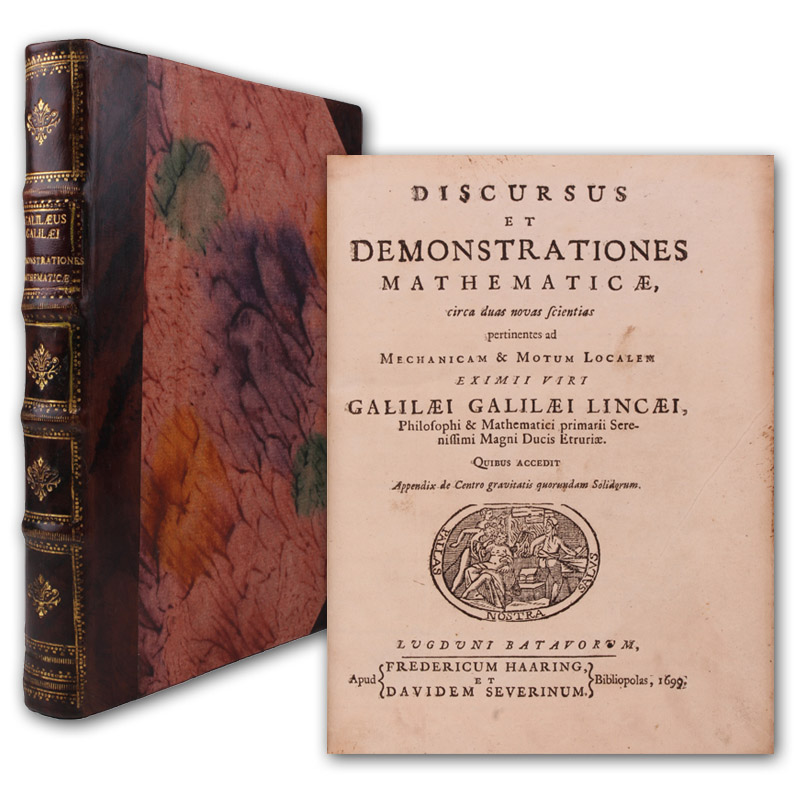100324-02
Discursus et demonstrationes mathematicae, circa duas novas scientias pertinentes ad mechanicam & motum localem.
Leyden, Haaring und Severin, 1699. - (21 x 16 cm). (6) 826 (richtig 282) (4) S. Mit zahlreichen Textholzschnitten. Dekorativer Halblederband der Zeit mit hübscher Rückenvergoldung.
Erste lateinische Ausgabe seiner berühmten, 1638 erstmals in Leyden erschienenen "Discorsi". - "Galileo's greatest work... In the 'Dialogo' Galileo had treated motion philosophically; here, continuing the medieval mathematical tradition, he proceeded to define uniform and accelerated motion correctly, and then to develop kinematics in a series of geometrical theorems, of which the most important is the result already announced in the 'Dialogo', that a uniformly accelerated body... travels over distances proportional to the square of the time taken in the descent. Here also is found Galileo's 'reductio ad absurdum' proof that acceleration is proportional to time... Mathematicians and physicists of the later seventeenth century, Isaac Newton among them, rightly supposed that Galileo had begun a new era in the science of mechanics. It was upon his foundations that Huygens, Newton and others were able to erect the fame of the science of dynamics, and to extend its range... to the heavenly bodies" (PMM). - Vorsatz etwas fleckig. Vereinzelt minimal stockfleckig bzw. gebräunt. Insgesamt schönes und gut erhaltenes Exemplar. - Cinti 166; Riccardi I, 513 (10/6); vgl. PMM 130 (EA)
Discursus et demonstrationes mathematicae, circa duas novas scientias pertinentes ad mechanicam & motum localem.
Leyden, Haaring und Severin, 1699. - (21 x 16 cm). (6) 826 (richtig 282) (4) S. Mit zahlreichen Textholzschnitten. Dekorativer Halblederband der Zeit mit hübscher Rückenvergoldung.
Erste lateinische Ausgabe seiner berühmten, 1638 erstmals in Leyden erschienenen "Discorsi". - "Galileo's greatest work... In the 'Dialogo' Galileo had treated motion philosophically; here, continuing the medieval mathematical tradition, he proceeded to define uniform and accelerated motion correctly, and then to develop kinematics in a series of geometrical theorems, of which the most important is the result already announced in the 'Dialogo', that a uniformly accelerated body... travels over distances proportional to the square of the time taken in the descent. Here also is found Galileo's 'reductio ad absurdum' proof that acceleration is proportional to time... Mathematicians and physicists of the later seventeenth century, Isaac Newton among them, rightly supposed that Galileo had begun a new era in the science of mechanics. It was upon his foundations that Huygens, Newton and others were able to erect the fame of the science of dynamics, and to extend its range... to the heavenly bodies" (PMM). - Vorsatz etwas fleckig. Vereinzelt minimal stockfleckig bzw. gebräunt. Insgesamt schönes und gut erhaltenes Exemplar. - Cinti 166; Riccardi I, 513 (10/6); vgl. PMM 130 (EA)
5.600 €

